Yakisoba: Japan's Iconic Stir-Fried Noodles
Yakisoba is a popular noodle stir-fried dish in Japan. It consists of meat, seafood, and vegetables flavored with a thick, sweet, and savory sauce that’s similar to Worcestershire sauce. Yakisoba can be eaten with a variety of toppings, including seaweed and pickled ginger.
Because of its name, many people wrongly believe yakisoba is made with fried soba noodles, which consist of buckwheat flour. In actuality, it uses a Chinese-style noodle called mushi chukamen, which is made from wheat flour.
Yakisoba is a significant part of Japanese street food cuisine. You’ll find it at various food stalls in the country, especially during festivals and fairs. The iconic meal is also common on the menus of izakaya (Japanese bars), teishoku-ya (Japanese diners), and even Japanese candy stores. Both the meal and its preparation are valuable parts of the country’s culture, as families will often gather around the fire to cook yakisoba.
In this post, we’ll delve into the details of yakisoba, including its origins, key components, recipes, and role in festivities.
Decoding Yakisoba: Ingredients and Origins
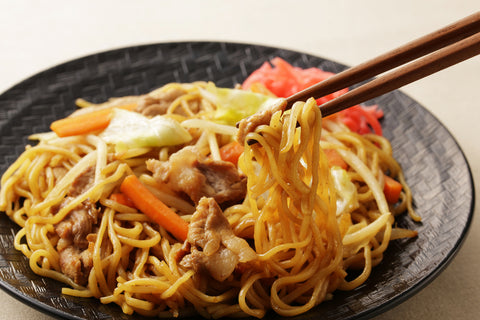
To understand yakisoba and its intricacies, you need to get a clear picture of its preparation. The process starts with the frying of wheat noodles similar to those used to make ramen. The noodles are combined with pork and vegetables, such as cabbage, onions, and carrots. After frying, the dish is flavored with the sauce, pepper, and salt. Lastly, toppings or garnishes are added to complete the dish.
Yakisoba may be a Japanese meal, but its origins are deeply rooted in Chinese chow mein. During the Meiji Era (1868–1912) Japan opened ports in various cities, which led to an influx of Chinese traders and immigrants. Some of them would serve Chinese noodles to workers at the ports. One of those dishes was the Chinese stir-fried noodles called chow mein. In the 1930s, chow mein was adapted to create a more localized dish, which turned out to be yakisoba.
The scarcity of flour in Japan after World War II led to people adding more of the readily available cabbage to the dish, further localizing it. The cabbages absorbed too much water, so people stopped seasoning them with soy sauce and switched to Worcester sauce. By the late 1950s, yakisoba had completed its evolution into a staple Japanese street food.
The Anatomy of Yakisoba: Noodles, Sauce, and Toppings

Now that you have a general idea of what constitutes yakisoba, it’s time to break down the Japanese stir-fried noodle dish into its core components and their unique characteristics.
The first and most important component of yakisoba is its noodles. The best noodles for making yakisoba are mushi chukamen, which are used for ramen noodles and are popular in Chinese cuisine. Wheat flour, kansui (an alkaline solution), and water are the main ingredients in their production.
We can group the second component as a combination of protein and vegetables. These are typically mixed with the noodles and fried. Yakisoba proteins can be meat, seafood, or a combination of both. Pork, beef, sirloin, shrimp, and prawn are examples of common proteins stir-fried with yakisoba noodles. For vegetables, carrot, cabbage, bean sprout, shiitake mushroom, onion, and tofu are common ingredients. If you’re on a vegetarian or vegan diet, you can leave out the protein and still enjoy the savory taste of yakisoba.
Another vital component of yakisoba is its sauce. There’s some flexibility when it comes to deciding what sauce to use. However, traditional yakisoba uses a special sauce, sometimes referred to as yakisoba sauce. You can make yakisoba sauce at home by combining different condiments, especially Worcestershire sauce, soy sauce, oyster sauce, and ketchup. We’ll provide a detailed yakisoba sauce guide later in this post.
The fourth and final yakisoba component is its toppings. You can garnish the meal with beni shoga (Japanese pickles), aonori (dried green seaweed), katsuobushi (dried bonito flakes), sesame oil, tsukemono (Japanese pickles), Japanese mayonnaise, and scallions.
These days, you don’t have to spend time preparing all the components of yakisoba. Try Myojo Ippeichan Yomise no Yakisoba to get your meal ready in a minute. The product comes frozen, fresh, and infused with the sauce and other seasonings.
The Healthful Side of Yakisoba: A Nutritional Overview
With four different components, yakisoba offers several positive health implications. It’s rich in protein, fiber, and energy. But what makes it a reliable health option is that you can easily customize it however you want. Hence, people include or swap ingredients to make yakisoba healthier. Check out some tips for making yakisoba healthier below:
-
Use more vegetables: You can add more healthy fiber to yakisoba by loading up on veggies such as carrots, cabbages, bean sprouts, broccoli, bell peppers, and more. People who have dietary restrictions can avoid adding proteins all together.
-
Limit the protein: If you can’t avoid protein all together, try more lean options, such as chicken breast or tofu. They’re healthier than high-fat foods like bacon or pork belly.
-
Use low-sodium soy sauce: Many pre-made sauces are high in sodium, especially soy sauce. Feel free to make your yakisoba sauce with low-sodium soy sauce.
-
Cook whole wheat noodles: Cooking yakisoba with whole wheat noodles instead of the traditional wheat noodles will help you reduce your intake of refined carbs.
-
Limit the oil: Avoid stir-frying the noodles with too much oil to reduce your cholesterol intake. You can also replace vegetable oil with olive or coconut oil.
-
Avoid extra seasoning: You don't have to add extra salt or other seasoning high in sodium when the meal already contains salty soy sauce.
Yakisoba's Role in Japanese Festivity and Street Fare
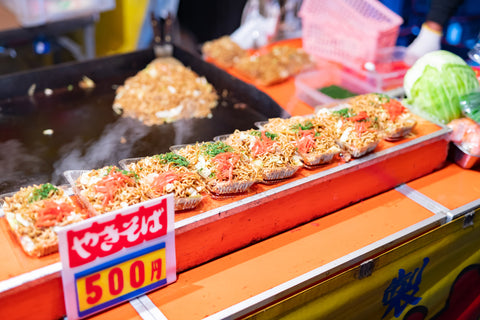
Despite how easy it is to customize yakisoba at home, it remains a popular street food, especially during the many matsuri (Japanese festivals) in the country. On evenings of events like Aomori Nebuta Matsuri, Sapporo Snow Festival, Gion Matsuri, and Cherry Blossom Festivals, you’ll find street food vendors selling hot plates of yakisoba in their stalls.
Even outside festival seasons, people walk down the roads of street food-centric cities like Fukuoka, Tokyo, and Osaka, trying different dishes from a variety of vendors. Yakosoba and other noodle dishes are favorites at such places. The vendors tend to open in the evenings, and they sell their meals via carts or stalls. This has been the case since the 1930s, when yakisoba became a known dish. Even after the invention of ready-made and instant noodles, thousands of people still patronize street vendors.
This is not to say that pre-made and instant noodles are not as tasty or popular. A trip to the supermarket will reveal different offerings, ranging from yakisoba instant noodles with sauce packets, like the Miyatake Teppan Yakisoba, to the infused variants we mentioned earlier. These offer convenience, versatility, and flexibility that cooking from scratch or buying at the stall do not.
Cooking Classic Yakisoba: A Culinary Walkthrough
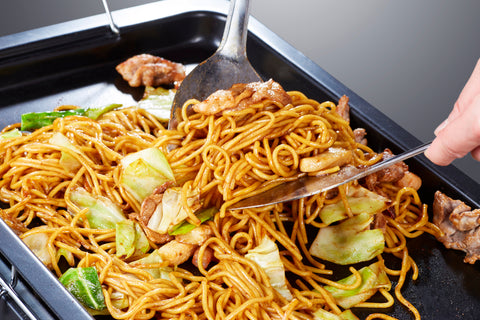
You now know enough about yakisoba to make your first one. In this section, we’ll guide you through the step-by-step process of cooking classic yakisoba at home. We’ll also be providing some vital cooking tips. But first, let’s discuss the ingredients needed for the recipe.
Yakisoba Recipe Ingredients:
-
Noodles: You’ll need about 16 oz of wheat flour noodles, which is equivalent to three servings.
-
Proteins: Our recipe uses a pound of boneless chicken, but feel free to use something else, including pork belly, shrimp, tofu, and calamari.
-
Vegetables: We’ll be using bell pepper, carrot, cabbage, and onions. Feel free to add more.
-
Sauce: We’ll use homemade yakisoba sauce. Check out our guide for making it in the next section.
-
Toppings: Anori and beni shoga are all the garnishes we need.
-
Neutral oil: We use avocado oil here, but olive oil isn’t bad either.
A Simple Guide to Making Yakisoba:
-
Gather all the ingredients.
-
Prepare yakisoba sauce using the method we’ll provide in this post.
-
Cut the vegetables and other ingredients into small pieces.
-
Using a griddle and medium heat, precook the noodles in neutral oil until they are loosened.
-
Transfer the noodles to a plate.
-
Stir-fry chicken on the hot griddle until the color changes. Add and cook onions for 1-2 minutes. Do the same for the carrots, then finally the cabbage and bell pepper.
-
Add noodles on top of the hot protein and vegetables.
-
Season the entire dish with yakisoba sauce.
-
Use a tong to combine all of the ingredients.
-
Garnish the dish with anori, beni shoga, and other toppings.
-
Turn off the heat from the griddle and transfer the cooked yakisoba to a plate. Serve while its still hot.
Cooking Tips to Remember:
-
You can use a frying pan or wok in place of a griddle. However, make sure whatever you use has a large space.
-
It’s more effective to loosen the preheated noodles before mixing them with other ingredients.
-
Don’t add too many ingredients at once while cooking.
-
To store yakisoba, put it in an airtight container and leave in the refrigerator or freezer, where it can last for three days and one month, respectively.
Crafting the Perfect Yakisoba Sauce
Yakisoba sauce is quite easy to make. All you need to do is follow the following simple instructions:. In a small bowl, whisk together half a cup of Worcestershire sauce, 4 teaspoons of soy sauce, 8 teaspoons of oyster sauce, 8 teaspoons of ketchup, and 4 teaspoons of sugar. Give it a quick taste to ensure it’s sweet enough for you.
Ideally, yakisoba sauce tastes sweet, tangy, and savory. If you find that it’s too bitter, add a little more sugar or some concentrated raisin juice. You can also adjust the taste without adding more sugar, although the process is a little more complex. More Worcestershire sauce makes the mixture more sour and more ketchup enhances its sweetness.
You don’t have to make your own yakisoba sauce. Many brands offer ready-made versions that capture the taste of authentic yakisoba sauce. Otafuku Yakisoba Sauce is one of the most popular of such products. It offers unparalleled taste and aroma. Otafuku yakisoba sauce makes the dish taste just like the ones prepared at street food stalls in Japan. The sauce is also good for other foods, like fried rice.
Creative Takes on Traditional Yakisoba
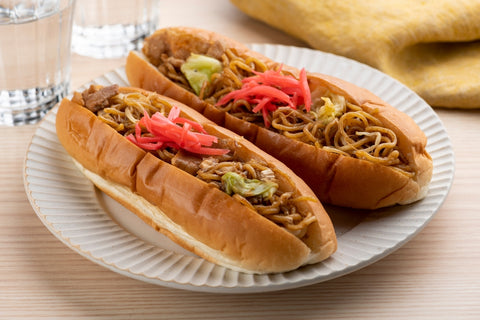
Let’s explore the different innovative and regional variations of yakisoba that showcase the dish's adaptability to different tastes and ingredients.
In Japan, several regions are famous for their innovative yakisoba variations. One of such regions is the island of Hokkaido, home to the Okhotsk kitami shio yakisoba, a salt-seasoned variant that doesn’t use sauce. From Hokkaido’s capital city comes the Sapporo Ichiban Chow Mein Yakisoba. This noodle pack is similar to chow mein and includes a flavor packet and dried seaweed toppings.
In Shizuoka, one of the most popular variations is fujinomiya yakisoba. It’s made with a specific kind of noodles, lardless meat, beni shoga, and pieces of seafood. Another popular regional variation in Japan is yokote yakisoba, from the city of Akita. It requires a special kind of pickle called fukujinzuke. We end our journey at Aomori, home to kuroishi tsuyu yakisoba, which is a type that’s made with a ramen-style noodle broth.
Sourcing Yakisoba Ingredients: Tips and Tricks
You don’t have to stray too far to find authentic ingredients for yakisoba. All you have to do is visit the nearest Asian grocery store or local market in your area. If you live in Japan, those establishments are much easier to find than if you lived in the United States.
That is where an online retailer like Bokksu Market can come in handy. We sell a variety of ingredients needed to make yakisoba from scratch.
You can also rely on us if you feel like treating yourself to instant yakisoba. Many of the instant yakisoba we sell contains unique ingredients that culminate in the perfect noodle snack. Hikari Menraku Yakisoba Bowl is a fantastic example. Although it has several variants, our favorite is the roasted shoyu version, which uses soy sauce, garlic, and tasty toppings to create an unbeatable flavor.
Complementing Yakisoba: Side Dishes and Pairings
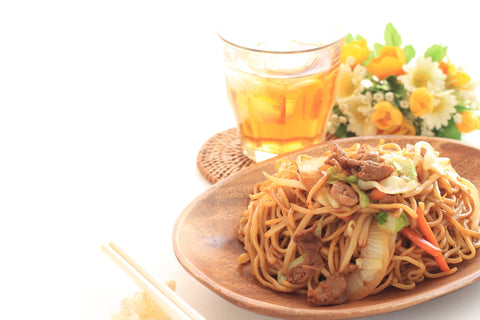
For a well-rounded dining experience, eat yakisoba alongside side dishes or drinks. Feel free to select pairings from our list of ideal accompaniments below:
-
Miso soup: The traditional Japanese soup made with dashi stock and miso paste is an excellent pairing for yakisoba. Add some scallions and mushrooms to enhance the taste even further.
-
Tamagoyaki: This raw egg side dish is one of the many Japanese stir fries sold on the streets. It offers a heartier perspective on yakisoba meals. Enjoy it with avocado or pickles.
-
Gyoza: The classic Japanese dumpling is a fantastic companion for yakisoba, especially when filled with pork, cabbage, and shredded pickled ginger.
-
Onigiri: Japanese rice balls seem to go with any dish. Yakisoba is not left out. Fill your onigiri with seafood or seaweed and enjoy it as a side dish.
-
Wakame: This salad is made with seaweed and some flavoring. It’s the perfect healthy companion for your yakisoba meal.
-
Green Tea: Matcha, sencha, and other green teas lend their earthy flavors to yakisoba when you enjoy them together.
-
Kasutera: The Japanese castella contains flour, honey, water, sugar, and eggs. It’s a sweet dessert to have with yakisoba.
-
Puree: Enjoy garlic puree and onion puree.
Yakisoba's Timeless Charm in Japanese Gastronomy
Yakisoba’s popularity has long since extended past the shores of Japan, and many foreign restaurants now serve the dish. It embodies the versatility, convenience, and festive nature of the Japanese culinary scene. Even after so many decades since the start of yakisoba’s existence, it remains one of the most popular street foods in Japan. If you’re looking for something new and authentic to try, we recommend yakisoba. Explore and enjoy this versatile dish.
Author Bio








